Much of the Wachowskis’ Jupiter Ascending takes place on alien worlds with vistas and creatures brought to life with complicated CG builds. But one scene, in which Jupiter (Mila Kunis) and Caine (Channing Tatum in antigravity boots) are pursued up and around the city of Chicago by alien ‘shadow’ spacecraft, required a more practical approach to shooting. Not only did the Wachowskis want to film the real actors and stunt doubles as much as possible, they also wanted to acquire real – and flexible – background plates.
– Catch a glimpse of the Chicago chase in this promo for the film.
The answer – at least for the background plates – lay in a multi-cam array developed for shoot. It would offer a chance to shoot panoramic plates that could then be stitched together. Dubbed the ‘Panocam,’ the array was developed in conjunction with Pictorvision and featured a set of six RED EPIC cameras stacked in two tiers of three. This could then be mounted in one of Pictorvision’s Eclipse camera rigs for stabilization (Pictorvision is now marketing their own Multi-Cam Array for use in film production.)
What this gave the filmmakers was a combined 140 horizontal degree and 60 vertical degree view with a resolution of around 12,000 pixels wide and 7,000 pixels high (the EPICs were shooting at three-and-a-half-K on Canon EF 24mm lenses). The stitched plates with this enlarged field of view then served as background plates in which Double Negative could add in various visual effects – more on this below.
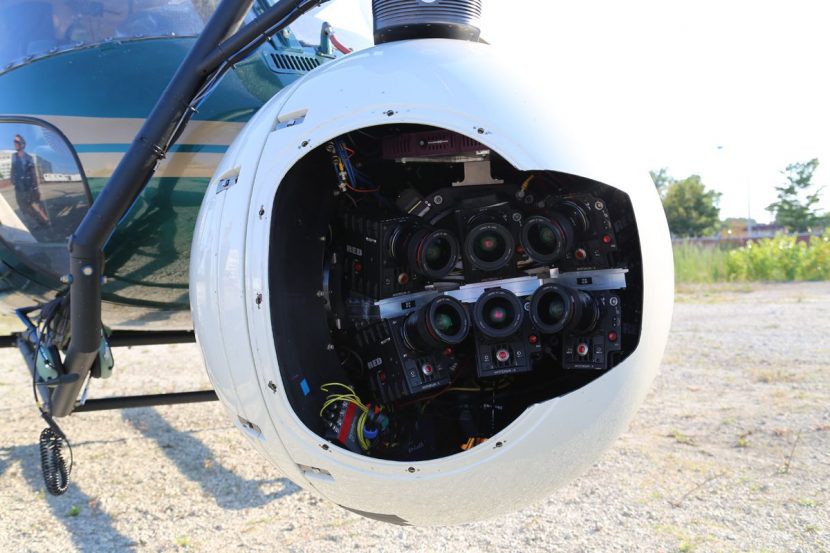
The Panocam approach had several benefits over normal plate shoots. One was simply the ability to capture so much so quickly. “Traditionally,” says overall Jupiter Ascending visual effects supervisor Dan Glass, “you’d station photographers atop many, many buildings and mid points and ground level stations and amass thousands if not millions of photographs to essentially map your city and project that onto basic geometry, and end up with something that looks pretty real and is photographic. But to actually take that to photoreal is a huge amount of effort that you don’t always have time for.”
In addition, the Chicago chase sequence was intended to take place in a pre-dawn light – the kind of light that occurs only 10 to 15 minutes before sunrise – providing for a distinctive saturated blue, while preserving the contrast from warm street lights and office buildings. “That time window is shockingly challenging to get everything you need in that time,” suggests Glass. “Previously you’d have to fly five to 10 flights to get all those views, so this enabled us to get material quickly that was very flexible and highly real looking.”
Video showing the Multi-Cam Array setup.
The helicopter paths were intricately planned based on previs and LIDAR data of Chicago. “We mapped the route that the shadows and Caine and Jupiter and the cameras would fly through Chicago,” explains Double Negative visual effects supervisor David Vickery. “The previs was based on real Chicago LIDAR, and we mapped out the route in order to re-create those views. And then we flew the helicopter down those routes.”
“We had these incredible days of photography getting up at 3am, prep’ing the chopper, waiting for that perfect 30 minutes of light and flying the paths as well as we could,” adds Vickery. “We found we would gain a stop every four or five minutes. We knew we’d have to do a lot of grading to re-balance our plates, but it did give us a fantastic basis for the entire sequence. And we worked out with the Panocam that we had captured the equivalent of an 11mm field of view. It gave us the flexibility to push in one that to 1:1 pixels to give us the equivalent of a 50mm lens.”
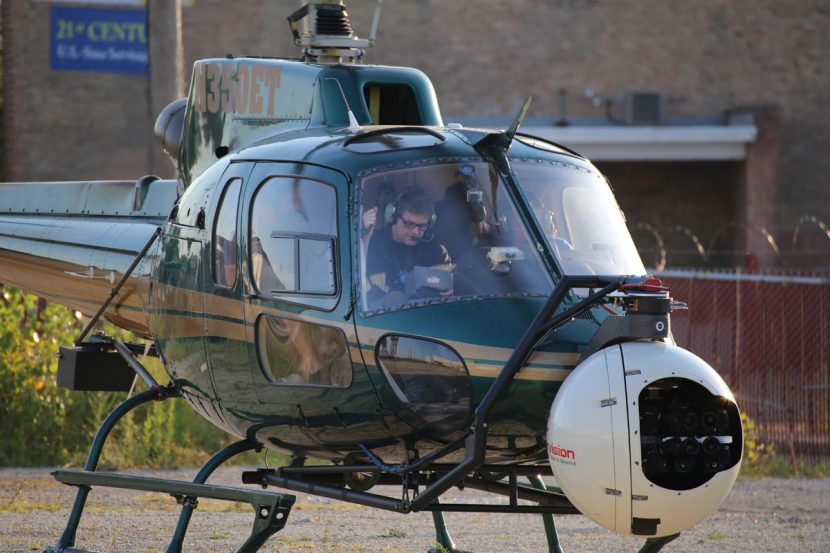
That matching process began with plate stitching. On set, a HD feed of the Panocam footage could be ‘smash-stitched’ via a NUKE script that Double Negative ran to view the plates. But in post, the studio relied on its proprietary stitching tool, Stig. “Because we knew the array and exactly how the cameras were positioned, we knew when they went on the mount they never got de-rigged until we finished using them,” says Vickery. “It meant that those arrays could run through exactly the same NUKE script and they could stitch back together the same way. It meant that our plates would stitch together almost perfectly – we wouldn’t even have issues with glass reflections.”
As shots were developed, one advantage of the wide field of view became clear – it allowed for some changes to be made in camera movement. “The animation would dictate that the camera needed to dive and swoop and sweep left and right, and fly a lot faster and more dynamically than any helicopter would be able to do,” says Vickery. “So we would have to take this fairly slow and linear camera move with the helicopter and project it back onto the LIDAR that we had of Chicago. And then based on that we could take a witness or hero animation camera and then deviate from the path of the helicopter through, and create a much more dynamic moves – diving, swooping, swirling.”
Footage from an aerial shoot of Los Angeles using Pictorvision’s Multi-Cam Array.
“Everything became a two-and-a-half-D projection,” states Vickery. “As much as everyone would like to say the helicopter photography was used exactly as it was shot, there always needed to be some sort of digital manipulation to it. But we knew it was photographically staying true to the light and the color temperature and detail of the city. But we could adjust the dynamic moves and add more energy. Then when it came to doing interactive lighting for explosions and boot trails and weapons fire, all of that stuff was already set up and rigged.”
Continuing their desire to capture as much in-camera as possible, the Wachowskis also sought to film real stunt performers hanging 50 feet below a helicopter as they ‘skated’ around Chicago’s skyscrapers thanks to the antigravity boots. This action was then captured from a second helicopter. “That was a highly elaborate thing to plan and seek permission for which took over 12 months,” describes Glass. “That footage was some of the ultimate grounding you can get – it instantly shows you what two people moving between buildings in the night sky looks like. It worked as an actual shot in the sequence and then everything had to match to it.”
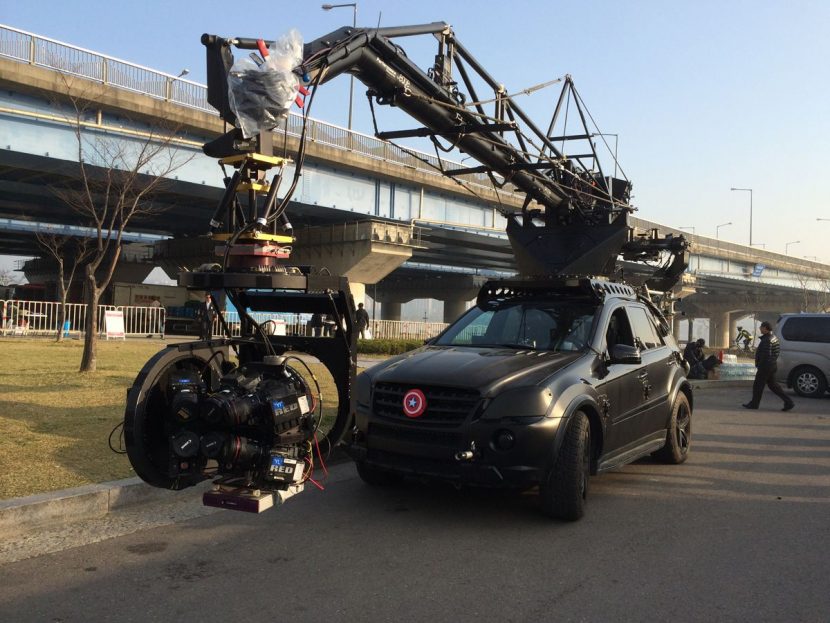
“In one take,” recalls Vickery on the practical stunt shoot, “the helicopter banked around a corner and the Channing double swung 45 degrees up. The pilot was saying later he looked to his left and he could see Channing’s double through the side of the helicopter past the co-pilot and he’d swung up beside – and at that point he thought he should go a little slower!”
Vickery adds that this technique of shooting stunts was mixed in with close-up and medium views of the principal actors on greenscreen, as well as digi-doubles where necessary. “The interesting thing about that is that usually wide shots become digi-doubles, then you’re left with close-ups and mediums on the greenscreen, and you get that weird dynamic where you know that the camera on a greenscreen is limited and you can’t get that far away and you know that filmmakers deliberately try and use digi-doubles when they’re really small in frame, but the Wachowskis were able to cover their live action from helicopter footage – aerial to aerial – and get medium shots of Channing actually in the city. And occasionally digi-doubles in close-up or as tiny characters. So they haven’t got trapped into using a close-up or a wide. You’re never quite sure – is it a stunt double, is it Channing, is it a digi-double?”
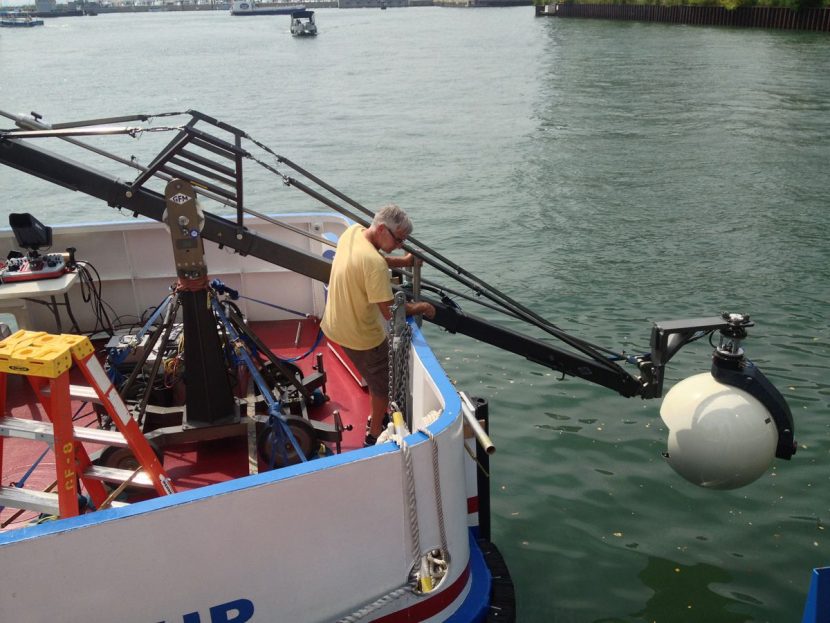
During the Chicago sequence, the shadows chase Caine and Jupiter through the canyon-like building spaces and around the Chicago river. In fact, they duck and weave over bridges, below them and even underwater. “Putting that together involved a lot of stitching,” notes Vickery. “We had to fly the route the shadows took down the river once with a helicopter. We’d start high and then swoop down low to the bridges and then we’d shoot it a second time with a barge which had a crane on the back that would allow us to get about 20 feet off the surface of the water at its highest point, but then it would also allow us to swoop down to just a foot off the surface and go underneath the bridges.”
“Then we could take the barge footage and helicopter footage,” adds Vickery, “re-time them so that they were traveling the same speed down the river, and stitch and do a digital two-and-a-half-D transition from the helicopter plate down onto the barge plate under the river, back over and onto a barge plate and into a helicopter plate to go under the next bridge. All at the same time we were doing digital water as the shadows were splashing down under the water and over.”
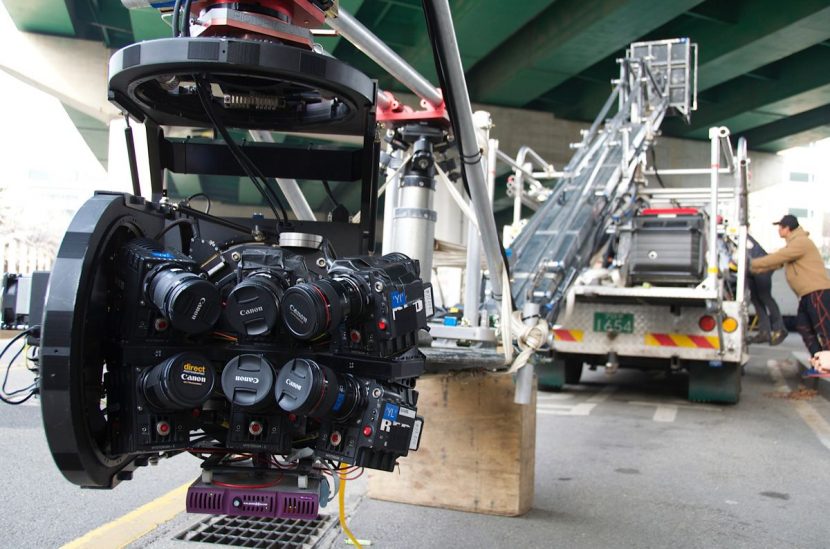
The shadows themselves were intricately designed craft with wings that acted as configurable panels. “They look a little like a stealth bomber,” remarks Vickery. “Each of the panels of the wing were completely independent from each other. And they were held together with this energy. The idea was that they could reconfigure themselves into different shapes and different designs – slightly origami-esque way. They could use this to help them bank and dive really quickly.”
Ultimately, one of the shadows dips its panel into the water like a rudder, sending a huge sheet of water to rise up and some following shadows to crash. “That’s a particularly beautiful sequence because the energy that holds these panels together is a blue glowing energy. For that we referenced, of all things, surfers at night. We found these cool videos with neon strips and glow sticks strapped onto their surfboards – surfing through cresting waves with this bright neon light everywhere.”
Watch this featurette for behind the scenes shots from the Chicago chase and other incredible work in the film.
Meanwhile, Double Negative also handled Caine’s antigravity boots and their trails for the chase. Importantly, the boots were not intended to be rocket blasters akin to, say, Iron Man’s propulsion system. “They were described as re-directing gravitational fields,” says Vickery. “Caine’s creating a cushion of air underneath his boots.”
Channing wore various boots depending on the stunt. If he was close to the ground, that necessitated rollerblades fitted with LED strips underneath to cast some interactive blue light. If he was in the air, the actor wore normal boats with LED strips on the side. Double Negative’s first job was just replacing the underside of the boots and painting out the rollerblades. “In extreme close-up you see the energy ports,” describes Vickery. “There are these elliptical energy ports and within that you can see all these tiny little louvers.”
Visual effects artists then had to generate motion trails from these louvers. “We did that based on the movement and action,” says Vickery. “So say if Caine was putting pressure down on his feet, we had the trails very brightened slightly. If he was lifting his feet, the trails would weaken. That was procedurally generated based on body tracking and animation.”
“In the close-up shots we had to do about 12 different effects passes,” notes Vickery. “Andy Wachowski was keen to demonstrate how gravity was essentially condensing and diffusing in and around and underneath his boots. So we had to reference the way oil dispersed on water and generate these really fine fluid dynamics passes – treating air like a liquid and trying to show the subtle vortices in the air in and around his boots. There’d be additional elements like general illumination changes, or the feeling of dust on the surface.”
“This approach to the film,” says Dan Glass, “was really part of the director’s intent to have some grounding in reality. That sounds strange for a sci-fi movie, but the Wachowskis were very keen that it felt physical and real, even though the characters are doing extraordinary things.”

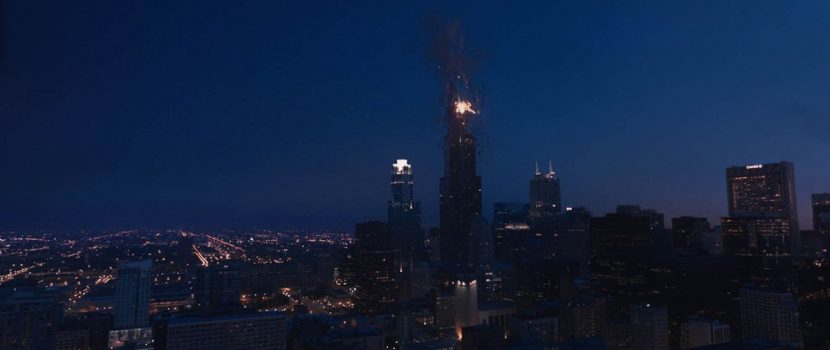
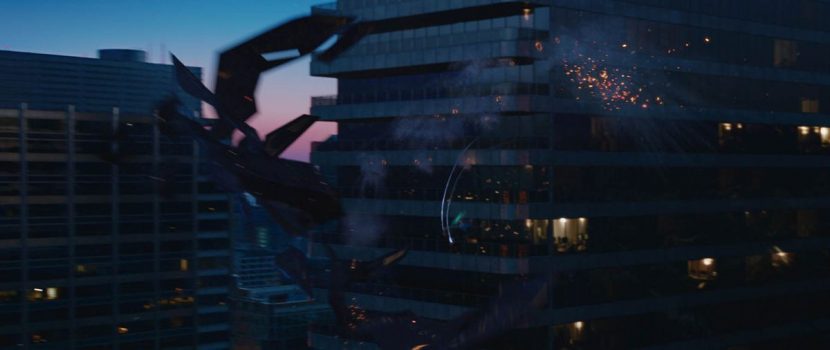
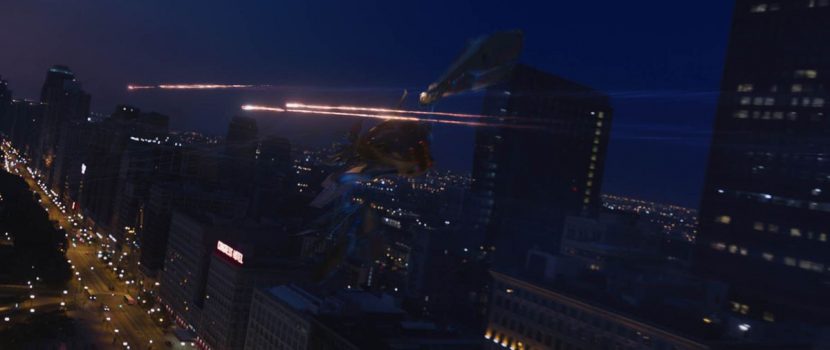
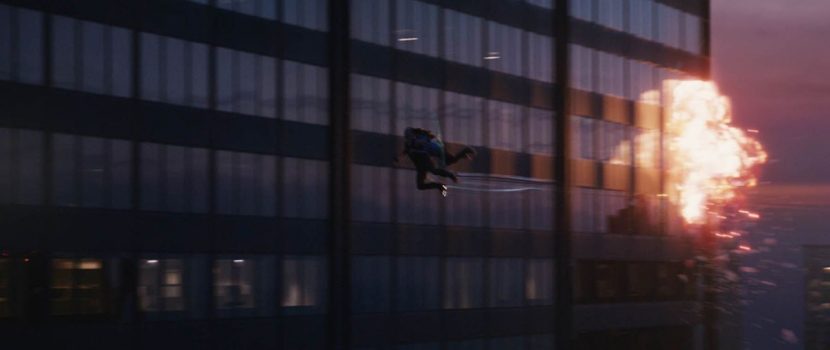
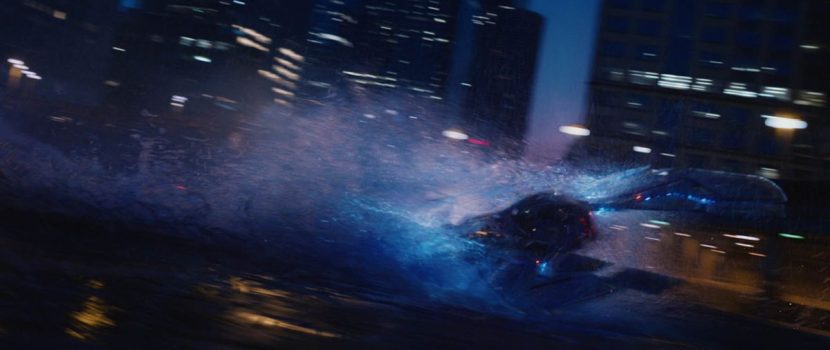
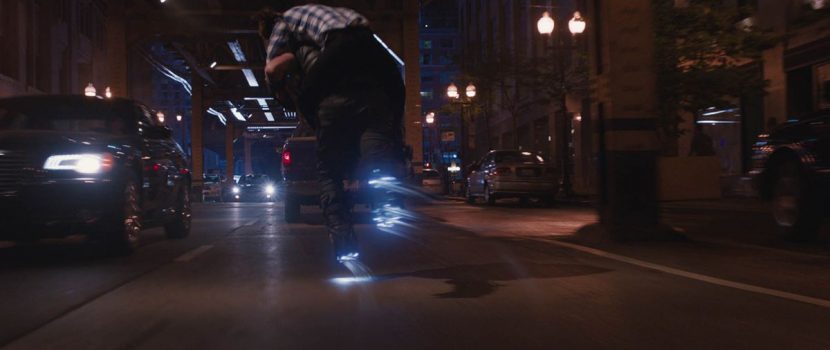
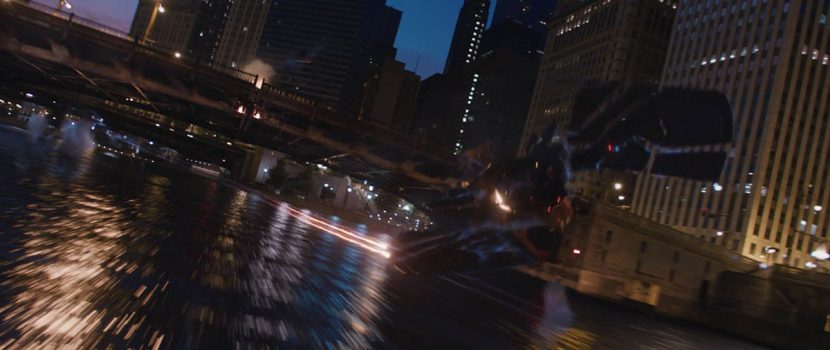
“The EPICs were shooting at three-and-a-half-K on Canon EF 24mm lenses.”
I believe that’s a bit misleading of a statement. The Epics appear in the BTS to be shooting 5k but the overlap works out such that on average only 3.5k worth of pixels is unique .